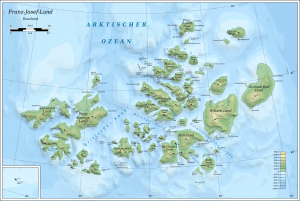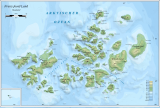Hooker Island
| Hooker Island | ||
|---|---|---|
| Map of the Franz Josef Land | ||
| Waters | Arctic Ocean | |
| Archipelago | Franz Josef Land | |
| Geographical location | 80 ° 14 ′ N , 53 ° 1 ′ E | |
|
|
||
| length | 32.8 km | |
| width | 29.9 km | |
| surface | 459.8 km² | |
| Highest elevation | Jackson dome 576 m |
|
| Residents | uninhabited | |
| main place | Buchta Tichaja (historical) |
|
| Location of Hooker Island | ||
The Hooker Island ( Russian остров Гукера , Ostrow Gukera ) is an uninhabited island in the arctic Franz Josef Land belonging to Russia .
geography
Hooker Island is the tenth largest island in the archipelago with an area of almost 460 km². It is located southeast of the British Canal and is separated from Prince George Land by it. To the south-west, behind De Bruyne Sound, lies Northbrook Island . There are some smaller islands in front of Hooker Island. The largest are Leigh Smith Island in the east, Royal Society Island in the northeast, and Scott Keltie Island in the northwest.
The island is covered by an ice cap , which reaches 576 m at its highest point, the Jackson dome ( Russian Купол Джексона , Kupol Dscheksona ). There are larger ice-free areas mainly in the west at Cape Dundee. In addition, some striking capes protrude from the ice sheet, especially Cape Markham and Cape Poole in the north and Cape Breitfuß in the southeast. Buchta Tichaja (Бухта Тихая, German Silent Bay ), a natural harbor in the northwest of the island, is bordered to the south by the Rubini rock, the most important bird cliff in Franz Josef Land. Above all, black-billed marmosets and kittiwakes breed here , but also crab grebes , black guillemots , fulmars , ice gulls , eider ducks , skuas and ivory gulls .
Fossils from the Upper Jurassic , such as the plesiosaur Peloneustes philarchus, have been found on Hooker Island .
history
The Hooker Island was first in 1874 by Julius Payer during the Austro-Hungarian Polar Expedition of McClintock Island spotted out. Its south coast was reached in 1880 and 1881/82 by Benjamin Leigh Smith , who named the island after the English botanist Joseph Dalton Hooker . It was first precisely mapped by the Jackson Harmsworth Expedition 1894–1897 . In 1913/14 the Russian expedition, led by Georgi Sedov , spent the winter in Buchta Tichaja, which gave Sedov its current name because the feared ice pressings did not occur. After the annexation of the archipelago, the Soviet Union opened the polar station “Buchta Tichaja” ( Russian полярная станция “Бухта Тихая” ) on August 29, 1929 , the first research station on Franz Josef Land. At times it had a crew of up to 50 people. On July 27, 1931, Hugo Eckener's airship LZ 127 Graf Zeppelin and the Soviet icebreaker Malygin met in Buchta Tichaja . In the same year, in preparation for the Second International Polar Year 1932/33, a magnetic observatory was built, the first director of which was Iwan Papanin . Since the polar station was closed in 1959, the island has no longer been permanently inhabited.
Individual evidence
- ↑ UNEP Islands (English)
- ↑ Meredith Williams, Julian A. Dowdeswell: Mapping seabird nesting habitats in Franz Josef Land, Russian High Arctic, using digital Landsat Thematic Mapper imagery . In: Polar Research . Volume 17, No. 1, 1998, pp. 15-30 (English). doi: 10.3402 / polar.v17i1.6604
- ^ MJ Benton, MA Shishkin, DM Unwin: The Age of Dinosaurs in Russia and Mongolia . Cambridge University Press, Cambridge 2000, p. 195 (English)
- ↑ Planet Wissen: Why did Graf Zeppelin plan his legendary expedition to the Arctic and which famous polar explorer did the surprise on the airship? , accessed December 26, 2010
- ↑ WJ Mills: Exploring Polar Frontiers - A Historical Encyclopedia , Vol. 1, ABC-CLIO, 2003, ISBN 1-57607-422-6 , p. 308 (English)
Web links
- Hooker Island on the website www.franz-josef-land.info
- Hooker Island topographic map , 1: 200,000




